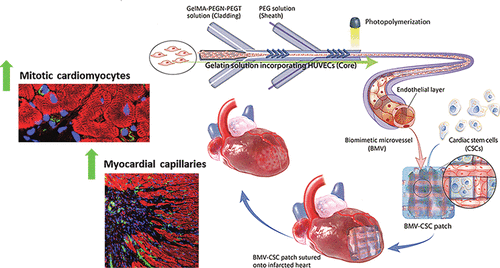当前位置:
X-MOL 学术
›
ACS Appl. Mater. Interfaces
›
论文详情
Our official English website, www.x-mol.net, welcomes your
feedback! (Note: you will need to create a separate account there.)
Cardiac Stem Cell Patch Integrated with Microengineered Blood Vessels Promotes Cardiomyocyte Proliferation and Neovascularization after Acute Myocardial Infarction
ACS Applied Materials & Interfaces ( IF 8.3 ) Pub Date : 2018-09-06 00:00:00 , DOI: 10.1021/acsami.8b13571 Teng Su 1, 2 , Ke Huang 1, 2 , Michael A. Daniele 1, 3 , Michael Taylor Hensley 1, 2 , Ashlyn T. Young 1 , Junnan Tang 2, 4 , Tyler A. Allen 1, 2 , Adam C. Vandergriff 1, 2 , Patrick D. Erb 1 , Frances S. Ligler 1 , Ke Cheng 1, 2, 5
ACS Applied Materials & Interfaces ( IF 8.3 ) Pub Date : 2018-09-06 00:00:00 , DOI: 10.1021/acsami.8b13571 Teng Su 1, 2 , Ke Huang 1, 2 , Michael A. Daniele 1, 3 , Michael Taylor Hensley 1, 2 , Ashlyn T. Young 1 , Junnan Tang 2, 4 , Tyler A. Allen 1, 2 , Adam C. Vandergriff 1, 2 , Patrick D. Erb 1 , Frances S. Ligler 1 , Ke Cheng 1, 2, 5
Affiliation

|
Cardiac stem cell (CSC) therapy has shown preclinical and clinical evidence for ischemic heart repair but is limited by low cellular engraftment and survival after transplantation. Previous versions of the cardiac patch strategy improve stem cell engraftment and encourage repair of cardiac tissue. However, cardiac patches that can enhance cardiomyogenesis and angiogenesis at the injured site remain elusive. Therapies that target cardiomyocyte proliferation and new blood vessel formation hold great potential for the protection against acute myocardial infarction (MI). Here, we report a new strategy for creating a vascularized cardiac patch in a facile and modular fashion by leveraging microfluidic hydrodynamic focusing to construct the biomimetic microvessels (BMVs) that include human umbilical vein endothelial cells (HUVECs) lining the luminal surface and then encapsulating the BMVs in a fibrin gel spiked with human CSCs. We show that the endothelialized BMVs mimicked the natural architecture and function of capillaries and that the resultant vascularized cardiac patch (BMV–CSC patch) exhibited equivalent release of paracrine factors compared to those of coculture of genuine human CSCs and HUVECs after 7 days of in vitro culture. In a rat model of acute MI, the BMV–CSC patch therapy induced profound mitotic activities of cardiomyocytes in the peri-infarct region 4 weeks post-treatment. A significant increase in myocardial capillary density was noted in the infarcted hearts that received BMV–CSC patch treatment compared to the infarcted hearts treated with conventional CSC patches. The striking therapeutic benefits and the fast and facile fabrication of the BMV–CSC patch make it promising for practical applications. Our findings suggest that the BMV–CSC patch strategy may open up new possibilities for the treatment of ischemic heart injury.
中文翻译:

心肌干细胞贴片与微工程血管整合促进急性心肌梗死后心肌细胞的增殖和新血管形成
心脏干细胞(CSC)治疗已显示出缺血性心脏修复的临床前和临床证据,但受细胞植入率低和移植后存活率的限制。心脏补丁策略的早期版本改善了干细胞的植入并促进了心脏组织的修复。但是,可以增强受损部位的心肌发生和血管生成的心脏斑块仍然难以捉摸。靶向心肌细胞增殖和新血管形成的疗法具有预防急性心肌梗塞(MI)的巨大潜力。这里,我们报告了一种新的策略,该方法可通过利用微流体流体动力聚焦来构建仿生微血管(BMV),包括以人脐静脉内皮细胞(HUVECs)排列在腔表面,然后将BMV封装在腔内,从而以便捷和模块化的方式创建带血管的心脏补丁。掺有人类CSC的纤维蛋白凝胶。我们显示内皮化的BMVs模仿了毛细血管的自然结构和功能,并且与真人CSCs和HUVECs的共培养相比,与真人CSCs和HUVECs的共培养相比,生成的带血管的心脏斑块(BMV–CSC斑块)表现出同等的旁分泌因子释放。文化。在急性心肌梗死的大鼠模型中,BMV–CSC贴片疗法在治疗后4周诱导了梗塞周围区域心肌细胞的深层有丝分裂活动。与使用常规CSC贴片治疗的梗塞心脏相比,接受BMV–CSC贴片治疗的梗塞心脏的心肌毛细血管密度显着增加。BMV–CSC贴片具有惊人的治疗优势和快速简便的制造工艺,使其在实际应用中大有前途。我们的发现表明,BMV–CSC修补策略可能为缺血性心脏病的治疗开辟新的可能性。
更新日期:2018-09-06
中文翻译:

心肌干细胞贴片与微工程血管整合促进急性心肌梗死后心肌细胞的增殖和新血管形成
心脏干细胞(CSC)治疗已显示出缺血性心脏修复的临床前和临床证据,但受细胞植入率低和移植后存活率的限制。心脏补丁策略的早期版本改善了干细胞的植入并促进了心脏组织的修复。但是,可以增强受损部位的心肌发生和血管生成的心脏斑块仍然难以捉摸。靶向心肌细胞增殖和新血管形成的疗法具有预防急性心肌梗塞(MI)的巨大潜力。这里,我们报告了一种新的策略,该方法可通过利用微流体流体动力聚焦来构建仿生微血管(BMV),包括以人脐静脉内皮细胞(HUVECs)排列在腔表面,然后将BMV封装在腔内,从而以便捷和模块化的方式创建带血管的心脏补丁。掺有人类CSC的纤维蛋白凝胶。我们显示内皮化的BMVs模仿了毛细血管的自然结构和功能,并且与真人CSCs和HUVECs的共培养相比,与真人CSCs和HUVECs的共培养相比,生成的带血管的心脏斑块(BMV–CSC斑块)表现出同等的旁分泌因子释放。文化。在急性心肌梗死的大鼠模型中,BMV–CSC贴片疗法在治疗后4周诱导了梗塞周围区域心肌细胞的深层有丝分裂活动。与使用常规CSC贴片治疗的梗塞心脏相比,接受BMV–CSC贴片治疗的梗塞心脏的心肌毛细血管密度显着增加。BMV–CSC贴片具有惊人的治疗优势和快速简便的制造工艺,使其在实际应用中大有前途。我们的发现表明,BMV–CSC修补策略可能为缺血性心脏病的治疗开辟新的可能性。















































 京公网安备 11010802027423号
京公网安备 11010802027423号